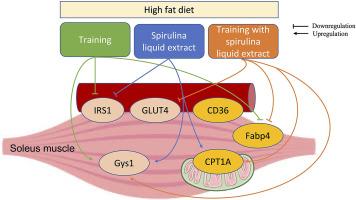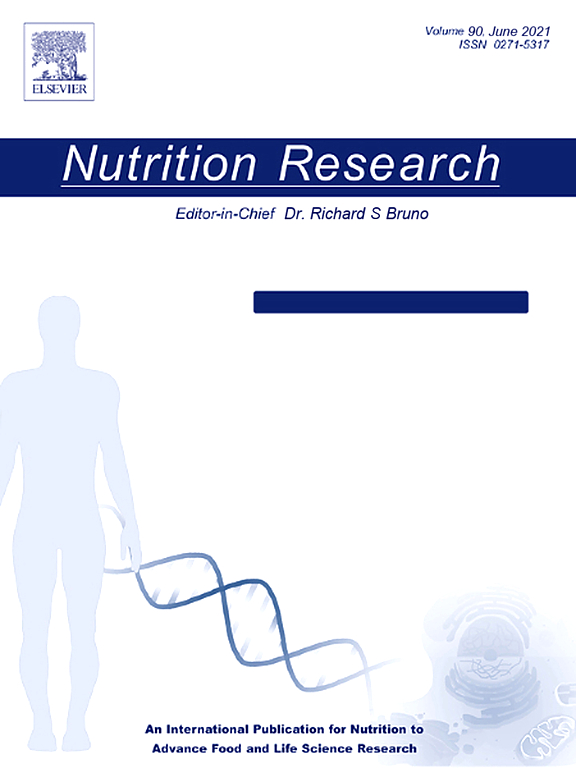Spirulina liquid extract regulates gene expression related to glucose and lipid metabolisms of soleus muscle during exercise training in young male Wistar rats fed a high-fat diet
IF 3.1
3区 医学
Q2 NUTRITION & DIETETICS
引用次数: 0
Abstract
Metabolic disorders induced by high-fat diets (HFD) contribute to obesity, diabetes, and cardiovascular diseases. While Spirulina liquid extract (SLE) has shown promise in improving lipid accumulation and insulin resistance, in vivo evidence remains limited, particularly in combination with exercise. Muscle activity is a key regulator of metabolism, but the potential combined effect of SLE and physical training under HFD conditions has not been established. In this study, young male rats were fed an HFD (60% energy from lipids) and assigned to four groups: HFD with 10% fructose (HFf), HFf with SLE (HFfSP), HFf with exercise (HFfT), and HFf with both interventions (HFfSPT). Bodyweight, lipid profiles, glycemia regulation, and gene expression in soleus muscle (SOL) of lipid and glucose metabolism were assessed. SLE reduced fasting glycemia compared to the HFf group (1.19-fold) and upregulated Gys1 (1.78-fold) and CPT1A expression (4.13-fold) in SOL. Training improved glucose tolerance, as reflected by reduced area under the curve (P = .01), and upregulated PGC1⍺ and CPT1A expression. The combined intervention (HFfSPT) decreased bodyweight, increased high-density lipoprotein-cholesterol (1.62-fold), reduced the atherogenic index of plasma (1.39-fold). During training conditions, PGC1⍺ expression was downregulated by SLE (3.03-fold), suggesting a possible interference with exercise-induced muscle adaptation. p38 MAPK, elevated by HFD, was downregulated by SLE, exercise, and their combination (3.20-, 5.14-, and 2.72-fold, respectively). Overall, these findings support the potential of SLE as a complementary strategy to exercise in attenuating HFD-induced metabolic dysfunctions, while also raising concerns about possible interference with training adaptations.

螺旋藻液体提取物在高脂饮食喂养的年轻雄性Wistar大鼠运动训练中调节比目鱼肌糖脂代谢相关基因表达
高脂肪饮食(HFD)引起的代谢紊乱会导致肥胖、糖尿病和心血管疾病。虽然螺旋藻液体提取物(SLE)已显示出改善脂质积累和胰岛素抵抗的希望,但体内证据仍然有限,特别是与运动相结合。肌肉活动是代谢的关键调节因子,但在HFD条件下SLE和体能训练的潜在联合效应尚未确定。在这项研究中,年轻雄性大鼠被喂食HFD(60%的能量来自脂质),并被分为四组:HFD加10%果糖(HFf)、HFf加SLE (HFfSP)、HFf加运动(HFfT)和HFf加两种干预(HFfSPT)。评估体重、脂质谱、血糖调节和比目鱼肌(SOL)中脂质和葡萄糖代谢的基因表达。与HFf组相比,SLE降低了空腹血糖(1.19倍),上调了SOL中的Gys1(1.78倍)和CPT1A表达(4.13倍)。训练改善了葡萄糖耐量,曲线下面积减少(P = 0.01),并上调了PGC1和CPT1A表达。联合干预(HFfSPT)降低体重,增加高密度脂蛋白-胆固醇(1.62倍),降低血浆动脉粥样硬化指数(1.39倍)。在训练条件下,PGC1的表达被SLE下调(3.03倍),提示可能干扰运动诱导的肌肉适应。HFD升高的p38 MAPK被SLE、运动及其联合下调(分别为3.20倍、5.14倍和2.72倍)。总的来说,这些发现支持SLE作为运动的补充策略,在减轻hfd诱导的代谢功能障碍方面的潜力,同时也引起了对可能干扰训练适应的担忧。
本文章由计算机程序翻译,如有差异,请以英文原文为准。
求助全文
约1分钟内获得全文
求助全文
来源期刊

Nutrition Research
医学-营养学
CiteScore
7.60
自引率
2.20%
发文量
107
审稿时长
58 days
期刊介绍:
Nutrition Research publishes original research articles, communications, and reviews on basic and applied nutrition. The mission of Nutrition Research is to serve as the journal for global communication of nutrition and life sciences research on diet and health. The field of nutrition sciences includes, but is not limited to, the study of nutrients during growth, reproduction, aging, health, and disease.
Articles covering basic and applied research on all aspects of nutrition sciences are encouraged, including: nutritional biochemistry and metabolism; metabolomics, nutrient gene interactions; nutrient requirements for health; nutrition and disease; digestion and absorption; nutritional anthropology; epidemiology; the influence of socioeconomic and cultural factors on nutrition of the individual and the community; the impact of nutrient intake on disease response and behavior; the consequences of nutritional deficiency on growth and development, endocrine and nervous systems, and immunity; nutrition and gut microbiota; food intolerance and allergy; nutrient drug interactions; nutrition and aging; nutrition and cancer; obesity; diabetes; and intervention programs.
 求助内容:
求助内容: 应助结果提醒方式:
应助结果提醒方式:


